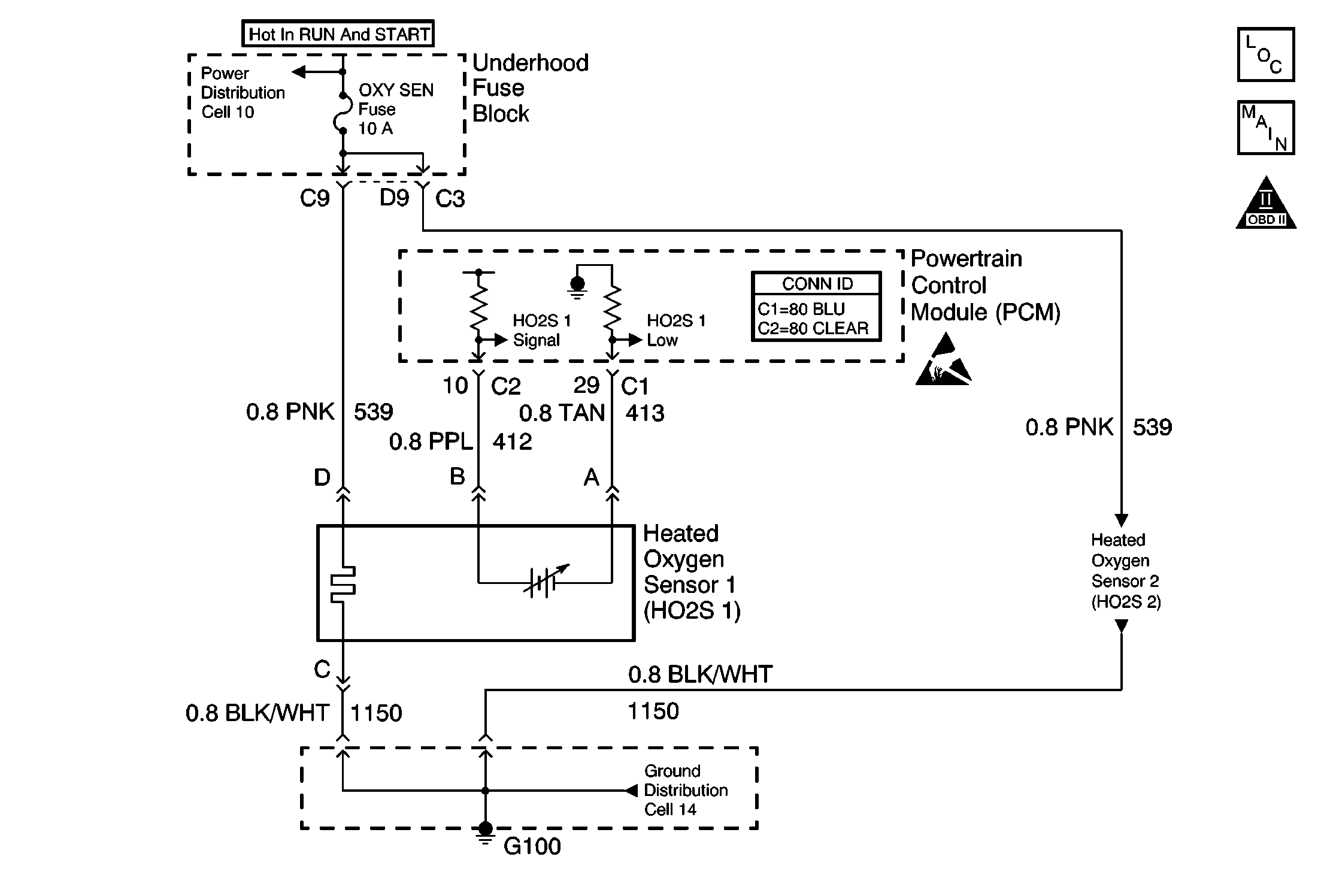
Circuit Description
The powertrain control module (PCM) supplies a bias voltage of about 450 mV between the HO2S high and low signal circuits. When measured with a 10 megohm digital voltmeter, this may display as low as 320 mV. The oxygen sensor varies the voltage within a range of about 1000 mV when the exhaust is rich, down through about 10 mV when exhaust is lean. The PCM constantly monitors the HO2S signal during closed loop operation and compensates for a rich or lean condition by decreasing or increasing injector pulse width as necessary. If the HO2S 2 voltage remains at or near the 450 mV bias for an extended period of time, DTC P0140 will be set, indicating an open sensor signal or sensor low circuit.
Conditions for Running the DTC
| • | None of the following active DTCs are present: |
| - | Throttle position (TP) sensor |
| - | Evaporative emissions (EVAP) system |
| - | Misfire |
| - | Intake air temperature (IAT) sensor |
| - | Manifold absolute pressure (MAP) sensor |
| - | Fuel trim |
| - | Fuel injector circuit |
| - | EGR pintle position |
| - | Engine coolant temperature (ECT) sensor |
| - | Crankshaft position (CKP) sensor |
| - | Mass air flow (MAF) sensor |
| • | The engine run time is more than 200 seconds (Vin 1) or 240 seconds (Vin K). |
Conditions for Setting the DTC
The HO2S 1 signal voltage remains between 425 mV and 475 mV for up to 90 seconds.
Action Taken When the DTC Sets
| • | The PCM will illuminate the malfunction indicator lamp (MIL) during the second consecutive trip in which the diagnostic test has been run and failed. |
| • | The PCM will store conditions which were present when the DTC set as Freeze Frame/Failure Records data. |
Conditions for Clearing the MIL/DTC
| • | The PCM will turn OFF the malfunction indicator lamp (MIL) during the third consecutive trip in which the diagnostic has run and passed. |
| • | The history DTC will clear after 40 consecutive warm-up cycles have occurred without a malfunction. |
| • | The DTC can be cleared by using a scan tool. |
Diagnostic Aids
Check for the following conditions:
| • | Any corroded exhaust flange attaching hardware--Using a DMM, ensure that continuity exists between the engine block and the heated oxygen sensor shell. If resistance is excessively high (over 500 ohms), replace the corroded exhaust flange attaching hardware as necessary. Refer to Front Pipe Replacement in Engine Exhaust. |
| • | A faulty connection or a damaged harness--Inspect the harness connectors for backed out terminals, improper mating, broken locks, improperly formed or damaged terminals, faulty terminal to wire connections, and a damaged harness. |
| • | A malfunctioning HO2S heater or heater circuit--With the ignition ON and the engine not running, the HO2S voltage displayed on a scan tool should decrease to less than 250 mV or increase to more than 600 mV within 2 minutes. If not, disconnect the HO2S and connect a test lamp between the HO2S ignition feed and heater ground circuits. If the test lamp does not illuminate, repair the open ignition feed or sensor ground circuit as necessary. If the test lamp illuminates and the HO2S signal and low circuits are OK, replace the affected HO2S. |
| • | With the ignition ON, monitor the HO2S signal voltage while moving the wiring harness and related connectors. If the malfunction is induced, the HO2S signal voltage will change. This may help isolate the location of the malfunction. |
Test Description
The numbers below refer to the step numbers on the diagnostic table.
-
If the DTC P0140 test passes while the Failure Records conditions are being duplicated, an intermittent condition is indicated.
Reviewing the Failure Records vehicle mileage since the diagnostic test last failed may help determine how often the condition that caused the DTC to be set occurs. This may assist in diagnosing the condition.
-
This vehicle is equipped with a PCM which utilizes an electrically erasable programmable read-only memory (EEPROM). When the PCM is replaced, the new PCM must be programmed.
Step | Action | Values | Yes | No | ||||
|---|---|---|---|---|---|---|---|---|
1 | Was the Powertrain On-Board Diagnostic (OBD) System Check performed? | -- | ||||||
2 |
Does the HO2S 2 voltage varying outside the specified values? | 400-475 mV | ||||||
Does the scan tool indicate the DTC failed this ignition? | -- | Go to Diagnostic Aids | ||||||
4 |
Is the HO2S 2 voltage less than the specified value? | 150 mV | ||||||
5 |
Does the HO2S 2 signal voltage approximately equal the specified value? | 4.5 V | ||||||
6 |
Was a problem found? | -- | ||||||
7 |
Was a problem found? | -- | ||||||
8 |
Was a problem found? | -- | ||||||
9 |
Was a problem found? | -- | ||||||
10 |
Was a problem found? | -- | ||||||
11 | Replace the HO2S 2. Refer to Heated Oxygen Sensor Replacement . Is the action complete? | -- | -- | |||||
|
Important: The replacement PCM must be programmed. Replace the PCM. Refer to Powertrain Control Module Replacement/Programming . Is action complete? | -- | -- | ||||||
13 |
Does the scan tool indicate the DTC failed this ignition? | -- | System OK |
